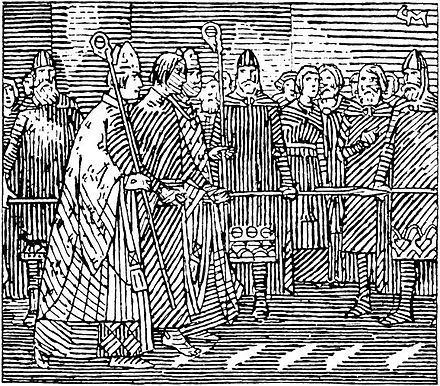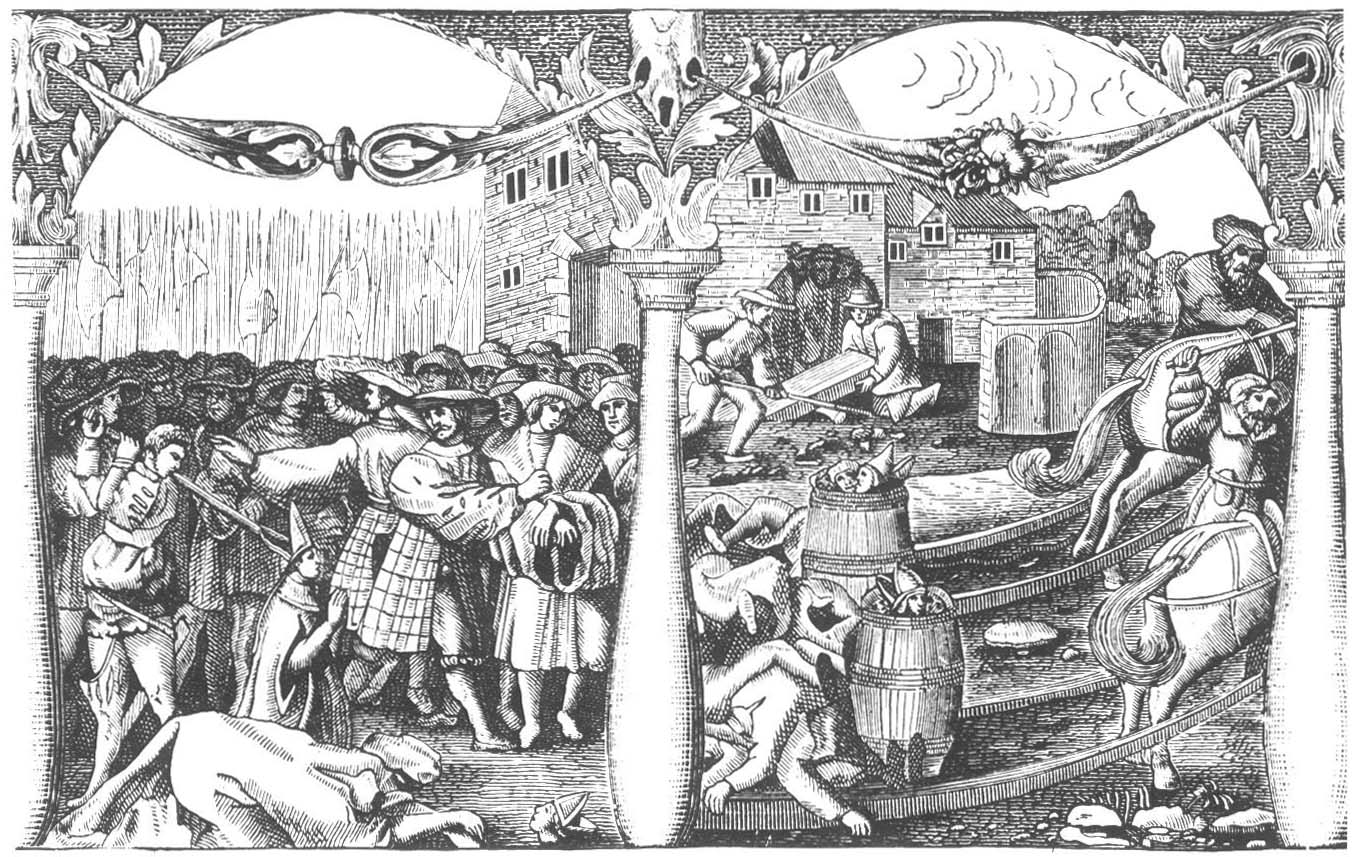In 872 various Scandinavian petty kingdoms unified in what would eventually become the kingdom of Norway under their first king, Harald Fairhair. As with many unifications, the first hundred years of their history is littered with depositions and internal conflicts. However, whereas most countries settle into their history, Norway’s line of kings is a rollercoaster of abdications, murder, depositions, and alliances with Denmark and/or Sweden. It wasn’t helped that the Laws of Succession were somewhat vague compared to their continental neighbours, leaving the throne open to multiple claimants at a time.
The first laws of succession were devised between a Jarl and a Norwegian bishop in 1163. When the throne of Norway was left vacant with the death of King Haakon II, Jarl Erling Skakke went to a bishop and pointed out that he had married the daughter of a king and therefore their son had a legitimate claim. The bishop said that if the new king would give the Holy Roman Church more power in Norway, he’d be happy to support his claim. Said new king was five years old at the time, so the negotiations were easily made on his behalf. The bishop crowned Erling’s son, King Magnus V of Norway, and Erling created himself an Earl so he could rule on his son’s behalf until he came of age.
With the power now firmly in their hands, Erling and the bishop devised new succession laws. Under the old customs, any son of a king could claim the throne jointly with his brothers. They could rule together or fight it out for a victor. Of course, all of their sons could then claim jointly, and so on and so on, leading to long periods of civil war. Erling’s system called for a single king with the succession left to primogeniture (the eldest son). If the son was unfit to inherit then a council of lay representatives could choose from the other royal sons. If there was still no one obvious, they could choose whoever they thought would do a good job. If they couldn’t agree then the bishops would decide. So although Erling created a law of succession it gave the power to elect the king to the changeable nobility, such as they were.
With primogeniture set in place and a coronation ceremony created for the first time, surely Norway’s succession troubles were over. Gone would be the days of civil war and the country would enjoy an uncontested line of kings.
Or not.
Magnus V was only fourteen years old when Sverre of Norway claimed to be the son of a previous king and demanded the throne. Enter: another period of civil war which would last until 1184 when Magnus was defeated in battle and killed. Sverre took the throne but the war didn’t end. In battling Magnus, Sverre had managed to incur blood feuds with a large number of the Jarls, and for good measure had alienated the church. Sverre died of an illness during the lengthy war, leaving the throne of Norway to his illegitimate son who became Haakon III.
Haakon III was king for two years before he died. With poison suspected, blame fell on Haakon’s practically stepmother with whom he had frequently quarrelled. To prove her innocence, she had a man walk through fire on her behalf. If he was burned then she was guilty. He was very badly burned, so she fled to Sweden, and Haakon’s illegitimate nephew, Guttorm succeeded at four years old. He was king for seven months before succumbing to a childhood illness.
Without an obvious successor, the council elected Inge II to the throne. Inge however, never married, and left only an illegitimate son and a nephew for the council to debate between. At this point a challenger appeared in the form of the illegitimate Haakon IV who claimed to be the son of Haakon III. When his mother successfully navigated a trial of ordeal (unlike that poisoner woman), Haakon III was elected, ruled for almost fifty years and finally put an end to the continuous struggles for the crown.

In the peaceful years that followed Norway allied with Sweden and in many instances shared a king. Nobody was deposed or overthrown until 1355 when Magnus IV of Sweden, VII of Norway, abdicated in favour of his son Haakon VI. There was no military coup or military struggle, Magnus was simply unpopular. His son Haakon had been raised in Norway with the intent of succeeding his father as king while Magnus spent little to no time there. Wanting a king of their own, the council had Magnus abdicate though he continued to act as the nominal regent until Haakon came of age. Magnus was even more unpopular in Sweden where he lavished titles and positions on a Duke rumoured to be his lover. He was deposed in 1364 and took refuge in Norway. Or would have, had his ship not been wrecked in the attempt and Magnus lost on the journey.
Perhaps one of the more successful of Scandinavian monarchs was Margaret I of Denmark, Norway, and Sweden. Through her, the three kingdoms she ruled were united, and it was her desire to see them remain unified after her death. When she came to choose her successor, she chose her adopted grand-nephew, Eric of Pomerania who became Eric III of Norway (VII of Denmark and XIII of Sweden). He was far less successful than his grand-aunt and was ousted from all three of his crowns. He initially might have retained the throne of Norway but his deposition from Denmark and Sweden had left him isolated. He was succeeded in his kingship by his nephew Christopher of Bavaria.
Christopher’s reign was short-lived. He died suddenly and unexpectedly in 1448 after seven years on the throne. Without a direct heir to any of his three kingdoms, two claimants stepped forward; Christian who married Christopher’s widow, Dorothea of Brandenburg, and Charles. Charles became King of Sweden, Christian of Denmark, and the two fought it out over Norway. Initially, Charles was also crowned King of Norway but seven months later, he was obliged to abdicate in favour of Christian. Incidentally, Charles became so unpopular in Sweden, he was eventually exiled and Christian was invited to rule as King of Sweden too, thus reunifying the the three countries.
Christian I was succeeded by his son John, and John by his son, Christian II. Christian II managed to alienate himself from the nobility before he even took the throne, and managed to further alienate them throughout his reign by curtailing their power. When his long time mistress died of suspected poison, Christian had one of the nobles tried for the crime. Initially, he was found innocent, so Christian had him tried again in a common court, and beheaded when he was found guilty. The nobles didn’t like that much either.
Christian then turned his attention to reclaiming the crown of Sweden which resulted in the deaths of so many Swedish nobles it was called the ‘Stockholm Bloodbath’. Christian was becoming increasingly unpopular and eventually, the nobles overthrew him in favour of his paternal uncle, another son of Christian I, Frederick.

After this, Norway enjoyed almost three hundred years of royal stability. When the Napoleonic Wars engulfed Europe, Norway suffered terribly. The King of Norway at the time was Frederick VI who also ruled Denmark. Over the three hundred years, Denmark and Norway had retained their alliance, albeit shakily, while Sweden had left the union. In 1814 King Frederick VI signed the Treaty of Kiel which passed Norway to Denmark. This prompted Norway to temporarily gain independence under their chosen ruler Christian Frederick. Christian Frederick was the son of Frederick VI and initially ruled as regent. As king, he ruled for three months before Sweden launched a successful military campaign into Norway. Christian Frederick was forced to abdicate in favour of King Charles XIII of Sweden.
The independence movement within Norway had gained some momentum from their brief stint as a kingdom in their own right. In 1872 Oscar II ascended the throne, and worked his entire life to grant Norway the independence they wanted. As a child, Oscar had never expected to become king. He was the third son of King Oscar I and Oscar’s successor, Charles XV himself had a son. However through a series of unfortunate deaths, Oscar became king.
Although he was based in Sweden, he appreciated that Norway wanted to be independent. He was the last king to abdicate. He did so in 1905 having worked to dissolve the acts of union that bound Norway and Sweden. In his place, his nephew Prince Carl was invited to assume the throne. Flattered, Carl said he would accept depending on the results of a referendum, asking the Norwegian people if they desired to continue with an hereditary monarchy. The referendum revealed that they did, and Carl was formally offered the throne, becoming King Haakon VII of Norway. Through the new king, the junior branch of the royal house of Christian I resumed the throne. So far, Haakon’s line have maintained their position having successfully passed the crown to the present incumbent; King Harald V.
If you’d like to join me for more fun and games in picking apart history, and other behind the scene tangents, you can support me via my Patreon.














